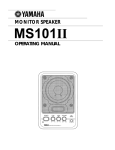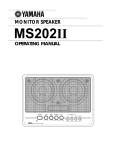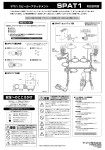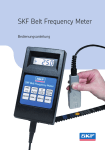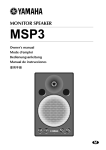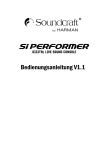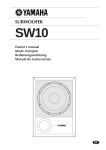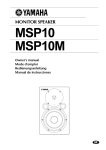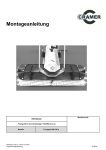Download Yamaha MS101 II Operating instructions
Transcript
MONITOR SPEAKER MS101II OPERATING MANUAL Thank you for purchasing a Yamaha MS101II Monitor Speaker. The MS101II employs a 4 inch full-range speaker in a compact bass-reflex style cabinet. Its faithful sound reproduction capabilities make it ideal for home recording and personal practice. Since a magnetic field-cancelling speaker is used, the MS101II can be placed next to a television or video monitor without causing interference, making it the perfect choice for Audio/Video system applications. ● Explanation of Graphical Symbols The lightning flash with arrowhead symbol, within an equilateral triangle is intended to alert you to the presence of uninsulated “dangerous voltage” within the product’s enclosure that may be of sufficient magnitude to constitute a risk of electric shock to persons. The exclamation point within an equilateral triangle is intended to alert you to the presence of important operating and maintenance (servicing) instructions in the literature accompanying the appliance. SAFETY INSTRUCTIONS 1. Read Instructions — All the safety and operating instructions should be read before the appliance is operated. 13. Cleaning — The appliance should be cleaned only as recommended by the manufacturer. 2. Retain Instructions — The safety and operating instructions should be retained for future reference. 3. Heed Warnings — All warnings on the appliance and in the operating instructions should be adhered to. 14. Nonuse Periods — The power cord of the appliance should be unplugged from the outlet when left unused for a long period of time. 4. Follow Instructions — All operating and use instructions should be followed. 5. Water and Moisture — The appliance should not be used near water — for example, near a bathtub, washbowl, kitchen sink, laundry tub, in a wet basement, or near a swimming pool, and the like. 6. Carts and Stands — The appliance should be used only with a cart or stand that is recommended by the manufacturer. 6A. An appliance and cart combination should be moved with care. Quick stops, excessive force, and uneven surfaces may cause the appliance and cart combination to overturn. 7. Wall or Ceiling Mounting — The appliance should be mounted to a wall or ceiling only as recommended by the manufacturer. 8. Ventilation — The appliance should be situated so that its location or position does not interfere with its proper ventilation. For example, the appliance should not be situated on a bed, sofa, rug, or similar surface that may block the ventilation openings; or placed in a built-in installation, such as a bookcase or cabinet that may impede the flow of air through the ventilation openings. 9. Heat — The appliance should be situated away from heat sources such as radiators, heat registers, stoves, or other appliances (including amplifiers) that produce heat. 10. Power Sources — The appliance should be connected to a power supply only of the type described in the operating instructions or as marked on the appliance. 11. Grounding or Polarization — The precautions that should be taken so that the grounding or polarization means of an appliance is not defeated. 12. Power-Cord Protection — Power-supply cords should be routed so that they are not likely to be walked on or pinched by items placed upon or against them, paying particular attention to cords at plugs, convenience receptacles, and the point where they exit from the appliance. 15. Object and Liquid Entry — Care should be taken so that objects do not fall and liquids are not spilled into the enclosure through openings. 16. Damage Requiring Service — The appliance should be serviced by qualified service personnel when: A. The power-supply cord or the plug has been damages; or B. Objects have fallen, or liquid has been spilled into the appliance; or C. The appliance has been exposed to rain; or D. The appliance does not appear to operate normally or exhibits a marked change in performance; or E. The appliance has been dropped, or the enclosure damaged. 17. Servicing — The user should not attempt to service the appliance beyond that described in the operating instructions. All other servicing should be referred to qualified service personnel. 18. Attachments — Do not use attachments not recommended by the product manufacturer as they may cause hazards. 19. Power Lines — An outside antenna system should not be located in the vicinity of overhead power lines or other electric light or power circuits, or where it can fall into such power lines or circuits. When installing an outside antenna system, extreme care should be taken to keep from touching such power lines or circuits as contact with them might be fatal. 20. Overloading — Do not overload wall outlets, extension cords, or integral convenience receptacles as this can result in a risk of fire or electric shock. 21. Replacement Parts — When replacement parts are required, be sure the service technician has used replacement parts specified by the manufacturer or have the same characteristics as the original part. Unauthorized substitutions may result in fire, electric shock, or other hazards. 22. Safety Check — Upon completion of any service or repairs to this product, ask the service technician to perform safety checks to determine that the product is in proper operating condition. IMPORTANT NOTICE FOR THE UNITED KINGDOM OBSERVERA! Apparaten kopplas inte ur växelströmskällan (nätet) så länge som den ar ansluten till vägguttaget, även om själva apparaten har stängts av. Connecting the Plug and Cord IMPORTANT:The wires in this mains lead are coloured in accordance with the following code: Blue Brown : : ADVARSEL: Netspæendingen til dette apparat er IKKE afbrudt, sålæenge netledningen siddr i en stikkontakt, som er t endt – også selvom der or slukket på apparatets afbryder. NEUTRAL LIVE VAROITUS: Laitteen toisiopiiriin kytketty käyttökytkin ei irroita koko laitetta verkosta. As the colours of the wires in the mains lead of this apparatus may not correspond with the coloured markings identifying the terminals in your plug, proceed as follows: CONTENTS The wire which is coloured BLUE must be connected to the terminal which is marked with the letter N or coloured BLACK. Precautions ..........................................................1 Front Panel / Rear Panel ......................................2 Example Set up....................................................3 Specifications .......................................................4 Block Diagram ......................................................4 Dimensions ..........................................................5 The wire which is coloured BROWN must be connected to the terminal which is marked with the letter L or coloured RED. Making sure that neither core is connected to the earth terminal of the three pin plug. Precautions ■ Warnings ■ Cautions 1. Connect this unit’s power cord only to an AC outlet of the type stated in this Owner’s Manual or as marked on the unit. Failure to do so is a fire and electrical shock hazard. 2. Do not allow water to enter this unit or allow the unit to become wet. Fire or electrical shock may result. 3. Do not place heavy objects, including this unit, on top of the power cord. A damaged power cord is a fire and electrical shock hazard. In particular, be careful not to place heavy objects on a power cord covered by a carpet. 4. Do not place a container with liquid or small metal objects on top of this unit. Liquid or metal objects inside this unit are a fire and electrical shock hazard. 5. Do not remove the unit’s cover. You could receive an electrical shock. If you think internal inspection, maintenance, or repair is necessary, contact your dealer. 6. Do not modify the unit. Doing so is a fire and electrical shock hazard. 7. If lightning begins to occur, turn off the power switch of the unit as soon as possible, and unplug the power cable plug from the electrical outlet. If there is a possibility of lightning, do not touch the power cable plug if it is still connected. Doing so may be an electrical shock hazard. 8. If the power cord is damaged (i.e., cut or a bare wire is exposed), ask your dealer for a replacement. Using the unit with a damaged power cord is a fire and electrical shock hazard. 9. If you notice any abnormality, such as smoke, odor, or noise, or if a foreign object or liquid gets inside the unit, turn it off immediately. Remove the power cord from the AC outlet. Consult your dealer for repair. Using the unit in this condition is a fire and electrical shock hazard. 10.Should this unit be dropped or the cabinet be damaged, turn the power switch off, remove the power plug from the AC outlet, and contact your dealer. If you continue using the unit without heeding this instruction, fire or electrical shock may result. 1. Keep this unit away from the following locations: Locations exposed to oil splashes or steam, such as near cooking stoves, humidifiers, etc. Unstable surfaces, such as a wobbly table or slope. Locations exposed to excessive heat, such as inside a car with all the windows closed, or places that receive direct sunlight. Locations subject to excessive humidity or dust accumulation. 2. Do not place the power cord close to a heater. It may melt, causing fire or electrical shock. 3. Hold the power cord plug when disconnecting it from an AC outlet. Never pull the cord. A damaged power cord is a potential fire and electrical shock hazard. Do not touch the power plug with wet hands. Doing so is a potential electrical shock hazard. 4. Use extreme caution when using a speaker stand and speaker bracket. 5. To relocate the unit, turn the power switch off, remove the power plug from the AC outlet, and remove all connecting cables. Damaged cables may cause fire or electrical shock. 6. Turn off all musical instruments, audio equipment, and speakers when connecting to this unit. Use the correct connecting cables and connect as specified. Always lower the volume control to minimum before turning on the power to this unit. A sudden blast of sound may damage your hearing. 7. Do not output distorted sounds for long periods of time, as this will cause the speaker to heat up, leading to a fire hazard. 8. If you know you will not use this unit for a long period of time, such as when going on vacation, remove the power plug from the AC outlet. Leaving it connected is a potential fire hazard. 9. To prevent electrical shock when cleaning the unit, remove the power plug from the AC outlet. 10.To allow for the efficient release of heat, maintain a gap of 10 cm or more between the rear of the MS101II and the wall in addition to a gap of 20 cm or more between the top of the MS101II and the ceiling. Locate the MS101II away from other equipment. If the release of heat is insufficient, the heat will remain inside the device, and result in a fire. 1 Front Panel / Rear Panel CAUTION: TO PREVENT ELECTRIC SHOCK, MATCH WIDE BLADE OF PLUG TO WIDE SLOT, FULLY INSERT. 1 STANDBY/ON switch/indicator 5 MIC INPUT Press this switch to switch the power between STANDBY and ON. When the power is turned on, the STANDBY/ON indicator comes on. A dynamic type microphone can be connected to this 1/4 inch phone jack. 6 Line 1 Input The line level output from a CD player, DAT recorder, cassette recorder, or VCR can be connected to this RCA pin jack. CAUTION: A small amount of electric current is flowing even when the power is in the STANDBY mode. When not using the MS101 II for an extended period of time, be sure to discon-nect the power cord from the AC outlet. 7 Line 2 Input Any audio equipment that produces a line level output can be connected to this 1/4 inch phone jack, i.e., synthesizer, mixer, multitrack cassette recorder, effects unit, etc. 2 LOW control Turn this control clockwise to boost low frequencies and counterclockwise to reduce them. 8 Line Out A cassette recorder or DAT recorder can be connected to this 1/4 inch phone jack for recording. Input signals from the Mic, Line 1, and Line 2 inputs are mixed, then output here. Another MS101II can be connected to this jack for parallel operation. The front panel volume knob doesn’t effect the volume level of this line out. 3 HIGH control Turn this control clockwise to boost high frequencies and counterclockwise to reduce them. 4 VOLUME control Use this control to set the volume level. 2 Example Set up Make sure all your equipment is powered off, then connect the MS101IIs power cable to a suitable AC receptacle. Connect your other equipment, synthesizer, CD player, etc., to the MS101II, then power on. There are many different ways in which the MS101IIs can be integrated into an audio system, two examples are shown below. Microphones are connected to the MIC INPUTs, a keyboard is connected to the LINE 2 input, and a CD player is connected to the LINE 1 input allowing you to sing and play along with your favorite songs or even your own songs. (Connect to the rear panel LINE INPUTs.) MS1012 MS1012 Microphone Microphone Synthesizer Cassette recorder Stereo System (Tape player, CD player, etc.) In this example, the monitor outputs of a Yamaha MD recorder Multitrack are connected to the LINE 2 inputs on a pair of MS101IIs for multitrack monitoring. Multi-track MD recorder 3 Specifications ● GENERAL SPECIFICATIONS Type ....................................... Bass Reflex Powered Speaker Frequency Range .................. 75 Hz — 18 kHz (LOW and HIGH controls at center) Max. SPL ............................... 97 dB SPL (10 W, 1 m on axis) Dimensions (W × H × D) ........ 147 × 214 × 192 mm (5.8 × 8.4 × 7.6 in) Weight.................................... 2.5 kg (5 lb 8 oz) ● SPEAKER SECTION Components .......................... JA1061 [10 cm (4 in), Cone] × 1 Sensitivity .............................. 87 dB SPL (1 W, 1 m on axis) Nominal Impedance............... 4 Ω ● AMP. SECTION Output Power ......................... 10 W at 1 kHz, THD = 0.5%, RL = 4 Ω Frequency Response............. 30 Hz — 20 kHz Input Sensitivity ..................... MIC: –45 dB / 2 kΩ / Phone Jack /Impedance............................ LINE 1: –10 dB / 10 kΩ / RCA Pin Jack /Connectors LINE 2: –10 dB / 10 kΩ / Phone Jack Hum & Noise ......................... ≤ –60 dB *(VOLUME: min, fc = 12.7 kHz, 6dB / oct LPF) Controls ................................. VOLUME LOW: –15 dB — +7 dB at 75 Hz HIGH: –13 dB — +8 dB at 10 kHz POWER: “ON/OFF” Power Requirement ............... AC120 V, 60 Hz / US & CANADIAN Models AC230 — 240V, 50/60 Hz / Other Models Power Consumption............... 30 W * 0 dB = 0.775 Vrms Block Diagram 4 STANDBY/ON LOW -10 +10 HIGH -10 +10 VOLUME MIN 199 (7.8˝ ) 214 (8.4˝ ) Dimensions MIC INPUT MAX MONITOR SPEAKER MS1012 60 (2.3˝ ) 147 (5.8˝ ) 2-M5 192 (7.6˝ ) Unit = mm (inch) SERVICE The MS101II is supported by Yamaha’s Worldwide network of factory trained and qualified dealer service personnel. In the event of a problem, contact your nearest Yamaha dealer. 5 ENCEINTES DE CONTROLE MS101II MODE D’EMPLOI Nous vous remercions d’avoir porté votre choix sur les enceintes de contrôle MS101II. La MS101II est équipée d’un haut-parleur 4 pouces pleine gamme dans un coffret compact de style bass-reflex. Sa fidélité de reproduction sonore en fait l’outil idéal pour les enregistrements personnels et les répétitions. La MS101II étant pourvue d’un haut-parleur annulant les champs magnétiques, elle peut être placée près d’un téléviseur ou d’un moniteur vidéo sans risque d’interférences. C’est donc le choix idéal pour toutes les applications audio-vidéo. Français TABLE DES MATIERES Précautions ..........................................................1 Panneau avant / Panneau arrière.........................2 Exemples de configuration ...................................3 Spécifications .......................................................4 Schéma de principe .............................................4 Dimensions ..........................................................5 Précautions ■ Avertissement ■ Attention 1. Ne branchez le cordon d’alimentation de cet appareil qu’à une prise secteur qui répond aux caractéristiques données dans ce manuel ou sur l’appareil, faute de quoi, il y a risque d’incendie. 2. Evitez de mouiller l’appareil ou de laisser pénétrer de l’eau dans son boîtier. Il y a risque d’incendie ou d’électrocution. 3. Ne posez pas d’objets pesants (à commencer par l’appareil lui-même) sur le cordon d’alimentation. Un cordon d’alimentation endommagé peut provoquer un incendie ou une électrocution. Cette précaution est notamment valable lorsque le cordon d’alimentation passe sous un tapis. 4. Ne posez pas de récipient contenant des liquides ou de petits objets métalliques sur l’appareil. Si un liquide ou des objets métalliques pénètrent dans l’appareil, il y a risque d’incendie ou d’électrocution. 5. N’ouvrez jamais le boîtier de cet appareil. Il y a risque d’électrocution. Si vous pensez que l’appareil doit subir une révision, un entretien ou une réparation, veuillez contacter votre revendeur. 6. Cet appareil ne peut pas être modifié par l’utilisateur. Il y a risque d’incendie ou d’électrocution. 7. En cas d’orage, veillez à mettre l’unité hors tension dès que possible et à débrancher le cordon d’alimentation de la prise murale. En cas d’orage avec des risques de foudre, évitez tout contact avec le cordon d’alimentation si ce dernier est toujours connecté à une prise murale. Vous éviterez ainsi une électrocution. 8. Si le cordon d’alimentation est endommagé (s’il est coupé ou si un fil est à nu), veuillez en demander un nouveau à votre revendeur. L’utilisation de l’appareil avec un cordon d’alimentation endommagé constitue un risque d’incendie ou d’électrocution. 9. Si vous remarquez un phénomène anormal tel que de la fumée, une odeur bizarre ou un bourdonnement ou, encore, si vous avez renversé du liquide ou des petits objets à l’intérieur, mettez l’appareil immédiatement hors tension et débranchez le cordon d’alimentation. Consultez votre revendeur pour faire examiner l’appareil. L’utilisation de l’appareil dans ces conditions constitue un risque d’incendie ou d’électrocution. 10.Lorsque l’appareil le boîtier d’alimentation tombe ou si le boîtier est endommagé, coupez l’alimentation, débranchez le cordon de la prise secteur et contactez votre revendeur. L’utilisation de l’appareil dans ces conditions constitue un risque d’incendie ou d’électrocution. 1. Evitez de placer l’appareil dans les endroits suivants: Les endroits soumis à des éclaboussures d’huile ou à de la vapeur (à proximité de cuisinières, d’humidificateurs, etc). Les endroits soumis à une chaleur excessive (à l’intérieur d’un véhicule toutes fenêtres fermées) ou en plein soleil. Les endroits particulièrement humides ou poussiéreux. 2. Ne placez jamais le cordon d’alimentation à proximité d’un dispositif de chauffage. Il pourrait fondre, ce qui constitue un risque d’incendie ou d’électrocution. 3. Soyez particulièrement prudent lors de l’utilisation de pieds ou de supports d’enceinte. 4. Débranchez toujours le cordon d’alimentation en tirant sur la prise et non sur le câble. Un cordon d’alimentation endommagé constitue un risque d’incendie ou d’électrocution. Ne touchez pas la prise d’alimentation avec des mains mouillées. Il y a risque d’électrocution. 5. Avant de changer cet appareil de place, coupez l’alimentation, débranchez le cordon d’alimentation de la prise secteur et débranchez tous les câbles de connexion. Des câbles endommagés constituent un risque d’incendie ou d’électrocution. 6. Coupez tous les instruments de musique, les appareils audio et les enceintes avant de les brancher à cet appareil. Utilisez les câbles de connexion adéquats et branchez-les selon les consignes données. Réglez le volume en position minimum avant de mettre cet appareil sous tension. Une explosion sonore brutale risque d’endommager votre ouïe. 7. Evitez de reproduire des signaux saturés pendant de longues périodes. Cela peut provoquer l’échauffement des haut-parleurs et éventuellement un incendie. 8. Si vous pensez ne pas utiliser cet appareil durant une longue période (si vous partez en vacance, par exemple), débranchez le cordon d’alimentation pour éviter tout risque d’incendie. 9. Pour éviter toute électrocution durant le nettoyage de l’appareil, débranchez le cordon d’alimentation au préalable. 10.Afin de permettre une évacuation efficace de la chaleur, gardez un espace de 10 cm ou plus entre l’arrière du MS101II et le mur, et de 20 cm entre le haut du MS101II et le plafond. Eloignez le MS101II de tout autre matériel. Si l’évacuation de la chaleur ne se fait pas convenablement, l’accumulation de chaleur risque de mettre le feu. 1 Panneau avant / Panneau arrière ATTENTION: POUR ÉVITER LES CHOCS ÉLECTRIQUES, INTRODUIRE LA LAME LA PLUS LARGE DE LA FICHE DANS LA BORNE CORRESPONDANTE DE LA PRISE ET POUSSER JUSQU’AU FOND. 1 Touche et témoin d’alimentation STANDBY/ON 5 Prise de microphone (MIC INPUT) Cette touche permet d’allumer la MS101II et de la mettre en attente. Appuyez sur la touche d’alimentation STANDBY/ON pour allumer la MS101II. Lorsqu’elle est allumée, le témoin s’allume. Vous pouvez brancher un microphone de type dynamique sur cette prise 6,35 mm. 6 Entrée de ligne (LINE 1 INPUT) Vous pouvez raccorder à cette prise RCA la sortie de niveau de ligne d’un lecteur CD, d’un magnétophone DAT, d’un magnétocassette ou d’un magnétoscope. Attention: Une petite quantité de courant circule lorsque le moniteur est en mode d’attente. Il est donc préférable de débrancher la prise secteur de l’enceinte si celle-ci ne sera pas utilisée pendant une période prolongée. 7 Entrée de ligne (LINE 2 INPUT) Vous pouvez raccorder à cette prise 6,35 mm un appareil audio produisant une sortie de niveau de ligne, comme un synthétiseur, un mélangeur, un magnétophone multipistes, un effecteur, etc. 2 Commande des graves (LOW) 8 Sortie de ligne (LINE OUT) Tournez cette commande vers la droite pour amplifier les basses fréquences et vers la gauche pour les atténuer. Vous pouvez raccorder à cette prise 6,35 mm un magnétocassette ou un magnétophone DAT pour l’enregistrement. Les signaux fournis aux entrées MIC, LINE 1 et LINE 2 sont mélangés puis sortis ici. Vous pouvez raccorder une autre MS101II à cette prise pour un fonctionnement en parallèle. La commande de volume du panneau avant n’a aucun effet sur le niveau de cette sortie de ligne. 3 Commande des aigus (HIGH) Tournez cette commande vers la droite pour amplifier les hautes fréquences et vers la gauche pour les atténuer. 4 Commande de volume (VOLUME) Cette commande sert à ajuster le volume sonore. 2 Exemples de configuration Vérifiez si tous les appareils sont hors tension, puis branchez le cordon d’alimentation de la MS101II sur une prise secteur adaptée. Raccordez vos autres appareils -- synthétiseur, lecteur CD, etc. -- à la MS101II, puis mettez-les appareils. Il y a de nombreuses façons d’intégrer la MS101II dans une chaîne audio. En voici deux exemples ci-dessous. Des microphones sont raccordés aux entrées MIC INPUT, un clavier à l’entrée LINE 2 et un lecteur CD à l’entrée LINE 1, ce qui vous permet de chanter et d’accompagner vos morceaux préférés, ou même vos propres compositions. (Raccorder aux entrées LINE INPUT sur le panneau arrière.) MS1012 MS1012 Microphone Microphone Synthétiseur Magnétocassette Chaîne stéréo (lecteur de cassette, lecteur CD, etc.) Dans l’exemple suivant, les sorties de contrôle (MONITOR) d’un graveur MD multipistes Yamaha sont raccordées aux entrées LINE 2 d’une paire de MS101II pour le contrôle multipistes. Magnéto MD multipistes 3 Spécifications ● SPECIFICATIONS GENERALES Type ......................................Enceinte amplifiée bass-reflex Plage de fréquence................75 Hz — 18 kHz (commandes LOW et HIGH au centre) Pression sonore maxi. ...........97 dB SPL (10 W, 1 m sur axe) Dimensions (L × H × P)..........147 × 214 × 192 mm (5,8 × 8,4 × 7,6 pouces) Poids ......................................2,5 kg (5 livres 8 onces) ● SECTION HAUT-PARLEUR Composants...........................JA1061 [10 cm (4 pouces), cône] × 1 Sensibilité ..............................87 dB SPL (1 W, 1 m sur axe) Impédance nominale .............4 Ω ● SECTION AMPLIFICATEUR Puissance de sortie ...............10 W à 1 kHz, DHT = 0,5 %, RL = 4 Ω Réponse en fréquence ..........30 Hz — 20 kHz Sensibilité d’entrée ................MIC: –45 dB/2 kΩ/Prise casque /Impédance ............................LINE 1: –10 dB/10 kΩ/Prise RCA /Connecteurs LINE 2: –10 dB/10 kΩ/Prise casque Bourdonnement et bruit de fond ............................................... ≤ –60 dB *(VOLUME: min, fc = 12,7 kHz, 6dB / oct LPF) Commandes ..........................VOLUME LOW: –15 dB — +7 dB à 75 Hz HIGH: –13 dB — +8 dB à 10 kHz POWER: “ON/OFF” Alimentation électrique ..........Secteur 120 V, 60 Hz / Modèles pour les U.S.A. et le Canada Secteur 230 — 240V, 50/60 Hz / Autres modèles Consommation électrique ......30 W * 0 dB = 0,775 Vrms Schéma de principe 4 STANDBY/ON LOW -10 +10 HIGH -10 +10 VOLUME MIN 199 (7,8˝ ) 214 (8,4˝ ) Dimensions MIC INPUT MAX MONITOR SPEAKER MS1012 60 (2,3˝ ) 147 (5,8˝ ) 192 (7,6˝ ) 2-M5 Unité = mm (pouches) REPARATION La MS101II peut être réparée par le réseau mondial de Yamaha, constitué de techniciens formés à l’usine et de concessionnaires qualifiés. En cas de difficulté, s’adresser au concessionnaire Yamaha le plus proche. 5 MONITOR-LAUTSPRECHER MS101II BEDIENUNGSANLEITUNG Vielen Dank, daß Sie sich für einen Yamaha MS101II Monitor-Lautsprecher entschieden haben. Der MS101II ist mit einer 4-Zoll-Vollbereich-Lautsprechereinheit in einem kompakten Baßreflex-Gehäuse ausgestattet. Mit seiner naturgetreuen Klangwiedergabe ist er ideal für Heimaufnahmen und Übungszwecke geeignet. Da der MS101II Magnetfelder wirkungsvoll unterdrückt, kann er auch neben einem Fernsehgerät oder Video-Monitor betrieben werden, ohne daß Interferenzen auftreten, so daß er die perfekte Wahl für Audio/Video-System-Anwendungen ist. INHALTSÜBERSICHT Vorsichtsmaßnahmen...........................................1 Vorderseite / Rückseite ........................................2 System-Beispiel ...................................................3 Technische Daten.................................................4 Blockschaltbild......................................................4 Abmessungen ......................................................5 Deutsch Vorsichtsmaßnahmen ■ Warnung ■ Achtung 1. Verbinden Sie das Netzkabel dieses Gerätes ausschließlich mit einer Netzsteckdose, die den Angaben in dieser Bedienungsanleitung entspricht. Tun Sie das nicht, so besteht Brandgefahr. 2. Vermeiden Sie, daß Wasser oder andere Flüssigkeiten in das Geräteinnere gelangen. Dann besteht nämlich Schlagoder Brandgefahr. 3. Stellen Sie keine schweren Gegenstände (also auch nicht dieses Gerät) auf das Netzkabel. Ein beschädigtes Netzkabel kann nämlich einen Stromschlag oder einen Brand verursachen. Auch wenn das Netzkabel unter dem Teppich verlegt wird, dürfen Sie keine schweren Gegenstände darauf stellen. 4. Stellen Sie keine Behälter mit Flüssigkeiten bzw. legen Sie keine kleinen Metallgegenstände auf das Gerät. Wenn diese nämlich in das Geräteinnere gelangen, besteht Brand- oder Schlaggefahr. 5. Öffnen Sie niemals die Haube dieses Gerätes, um sich nicht unnötig einem Stromschlag auszusetzen. Wenn Sie vermuten, daß das Gerät nachgesehen, gewartet oder repariert werden muß, wenden Sie sich bitte an Ihren Händler. 6. Dieses Gerät darf vom Anwender nicht modifiziert werden. Dabei bestehen nämlich Brand- und Schlaggefahr. 7. Im Falle eines Gewitters sollten Sie das Gerät so schnell wie möglich ausschalten und den Netzanschluß lösen. Wenn die Möglichkeit eines Blitzeinschlages besteht, dürfen Sie auf keinen Fall das Netzkabel berühren, solange es noch an die Steckdose angeschlossen ist. Sonst besteht Stromschlaggefahr. 8. Wenn das Netzkabel beschädigt ist (d.h. wenn eine Ader blank liegt), bitten Sie ihren Händler um ein neues. Bei Verwendung dieses Gerätes mit einem beschädigten Netzkabel bestehen Brand- und Schlaggefahr. 9. Wenn Ihnen etwas Abnormales auffällt, z.B. Rauch, starker Geruch oder Brummen bzw. wenn ein Fremdkörper oder eine Flüssigkeit in das Geräteinnere gelangt, müssen Sie es sofort ausschalten und den Netzanschluß lösen. Reichen Sie das Gerät anschließend zur Reparatur ein. Verwenden Sie es auf keinen Fall weiter, weil dann Brand- und Schlaggefahr bestehen. 10.Wenn das Gerät hinfällt bzw. wenn das Gehäuse sichtbare Schäden aufweist, müssen Sie es sofort ausschalten, den Netzanschluß lösen und sich an Ihren Händler wenden. Bei Nichtbeachtung dieses Hinweises bestehen Brandund Schlaggefahr. 1. Stellen Sie das Gerät niemals an einen der folgenden Orte: Orte, wo Öl verspritzt wird bzw. wo es zu starker Kondensbildung kommt, z.B. in der Nähe eines Herdes, Luftbefeuchtigers usw. Übermäßig heiße Orte, z.B. in einem Auto, dessen Fenster geschlossen sind oder Orte, die direkter Sonneneinstrahlung ausgesetzt sind. Übermäßig feuchte oder staubige Orte. 2. Legen Sie das Netzkabel niemals in die Nähe eines Heizkörpers. Sonst kann es nämlich schmelzen, so daß Brand und Schlaggefahr bestehen. 3. Ziehen Sie beim Lösen des Netzanschlusses immer am Stecker und niemals am Netzkabel. Sonst können nämlich die Adern reißen, so daß Brand- oder Schlaggefahr besteht. Berühren Sie das Netzkabel niemals mit feuchten Händen. Sonst besteht nämlich Schlaggefahr. 4. Seien Sie besonders vorsichtig, wenn Sie einen Boxenständer und Boxenbügel verwenden. 5. Vor dem Transport dieses Gerätes müssen Sie es ausschalten, den Netzanschluß lösen und alle Anschlußkabel entfernen. Beschädigte Kabel können zu Brand- oder Schlaggefahr führen. 6. Schalten Sie alle Musikinstrumente, Audiogeräte und Boxen aus, bevor Sie sie an dieses Gerät anschließen. Verwenden Sie ausschließlich geeignete Anschlußkabel und befolgen Sie die Anschlußhinweise. Stellen Sie die Lautstärke vor Einschalten dieses Gerätes auf den Mindestwert. Bei plötzlichem Einsetzen sehr lauter Signale könnte nämlich Ihr Gehör beschädigt werden. 7. Geben Sie niemals über einen längeren Zeitraum verzerrte Signale aus. Das kann nämlich zu einer Erhitzung der Lautsprecher und zu Brand führen. 8. Wenn Sie dieses Gerät längere Zeit nicht verwenden möchten, z.B. weil Sie in Urlaub fahren, lösen Sie am besten den Netzanschluß. Sonst besteht nämlich Brandgefahr. 9. Um zu vermeiden, daß Sie beim Reinigen des Gerätes einen Stromschlag bekommen, sollten Sie vorher den Netzanschluß lösen. 10.Um eine ausreichende Wärmeabfuhr zu gewährleisten, sollten Sie zwischen der Rückseite und der Wand mindestens 10 cm und zwischen der Oberseite des MS101II und der Decke 20 cm Freiraum lassen. Wärmestaus führen bekanntlich zu Brandgefahr. 1 Vorderseite / Rückseite 1 STANDBY/ON-Netzschalter/Anzeige 5 Mikrofoneingang (MIC INPUT) Dieser Schalter schaltet zwischen Ein und Bereitschaftsbetrieb um. Den STANDBY/ON-Schalter drücken, um einzuschalten. In eingeschaltetem Zustand erscheint die STANDBY/ON-Anzeige. Hier kann ein dynamisches Mikrofon mit einem 1/4-ZollKlinkenstecker angeschlossen werden. 6 Eingang 1 (Line 1) Ein CD-Spieler, DAT-Recorder, Cassettenrecorder oder Videorecorder kann an diese RCA-Stiftbuchse angeschlossen werden. Vorsicht: Eine geringe Menge Strom fließt auch, wenn die Betriebsstromversorgung im STANDBY-Betrieb ist. Wenn der MS101 II längere Zeit nicht verwendet werden soll, immer den Netzstekker aus der Steckdose ziehen. 7 Eingang 2 (Line 2) Jedes Audio-Gerät, das einen Direktausgangspegel erzeugt, kann an diese 1/4-Zoll-Klinkenbuchse angeschlossen werden, d.h. Synthesizer, Mixer, Multitrack-Cassettenrecorder, Effektgeräte usw. 2 Baßregler (LOW) Diesen Regler im Uhrzeigersinn drehen, um die Bässe zu verstärken, im Gegenuhrzeigersinn, um sie abzuschwächen. 8 Ausgang (Line Out) An diese 1/4-Zoll-Klinkenbuchse kann ein Cassettenrecorder oder ein DAT-Recorder zur Aufnahme angeschlossen werden. Eingangssignale von Mic, Line 1 und Line 2 werden gemischt und dann hier ausgegeben. Ein weiterer MS101II kann an dieser Buchse für Parallelbetrieb angeschlossen werden. Der Lautstärkeregler an der Vorderseite hat keinen Einfluß auf den Lautstärkepegel dieses Direktausgangs. 3 Höhenregler (HIGH) Diesen Regler im Uhrzeigersinn drehen, um die Höhen zu verstärken, im Gegenuhrzeigersinn, um sie abzuschwächen. 4 Lautstärkeregler (VOLUME) Mit diesem Regler kann die Lautstärke eingestellt werden. 2 System-Beispiel Zuerst müssen alle Geräte ausgeschaltet werden. Dann das Netzkabel des MS101II an eine geeignete Netzsteckdose anschließen. Andere Ausrüstungen, wie z.B. Synthesizer, CD-Spieler usw. an die MS101II anschließen, dann die Geräte einschalten. Es gibt viele verschiedene Möglichkeiten zur Integration der MS101II in eine Stereo-Anlage. Es folgen nur zwei Beispiele. Mikrofone sind an den MIC INPUTs angeschlossen, ein Keyboard ist an dem LINE 2-Eingang angeschlossen, ein CD-Spieler am LINE 1-Eingang, so daß Sie mit ihren Lieblingstiteln oder sogar mit ihren eigenen Titeln mitsingen und mitspielen können. (An die LINE INPUT-Anschlüsse auf der Rückseite anschließen) MS1012 MS1012 Mikrofon Mikrofon Synthesizer Cassettenrecorder Stereo-Anlage (Cassettenspieler, CD-Spieler usw.) In diesem Beispiel sind die Monitorausgänge eines Yamaha Multitrack-MD-Rekorders mit den LINE 2-Eingängen an einem MS101II-Paar für Multispur-Abhörkontrolle angeschlossen. Multitrack-MD-Rekorder 3 Technische Daten ● ALLGEMEINE DATEN Typ .........................................Baßreflex-Aktivlautsprecher Frequenzgang........................75 Hz — 18 kHz (Tiefen- und Höhen-Regler in Mitteleinstellung) Max. SDP...............................97 dB SPL (10 W, 1 m auf Achse) Abmessungen (B × H × T) .....147 × 214 × 192 mm (5,8 × 8,4 × 7,6 in) Gewicht ..................................2,5 kg (5 livres 8 onces) ● LAUTSPRECHERSYSTEM Einheiten................................JA1061 [10 cm, Konus] × 1 Schalldruckpegel ...................87 dB SPL (1 W, 1 m auf Achse) Nennimpedanz.......................4 Ω ● VERSTÄRKERTEIL Ausgangsleistung ..................10 W bei 1 kHz, THD = 0,5%, RL = 4Ω Frequenzgang ..........................30 Hz — 20 kHz Eingangsempfindlichkeit ........MIC: –45 dB/2 kΩ/Klinkenbuchse /Impedanz ..............................LINE 1: –10 dB/10 kΩ/RCA-Stiftbuchse /Anschlüsse LINE 2: –10 dB/10 kΩ/Klinkenbuchse Brummen und Rauschen ....... ≤ – 60 dB *(min. Lautstärke, fc =12,7 kHz, 6 dB /oct LPF) Regler ....................................VOLUME LOW: –15 dB — +7 dB bei 75 Hz HIGH: –13 dB — +8 dB bei 10 kHz POWER: “EIN/AUS” Stromversorgung ...................120 V Wechselspannung, 60 Hz/USA- u. Kanada-Modelle 230 — 240V Wechselspannung, 50/60 Hz/Andere Modelle Leistungsaufnahme ...............30 W * 0 dB = 0,775 V Blockschaltbild 4 STANDBY/ON LOW -10 +10 HIGH -10 +10 VOLUME MIN 199 (7,8˝ ) 214 (8,4˝ ) Abmessungen MIC INPUT MAX MONITOR SPEAKER MS1012 60 (2,3˝ ) 2-M5 147 (5,8˝ ) 192 (7,6˝ ) Einheit = mm (Zoll) KUNDENDIENST Der MS101II wird vom weltweiten Yamaha-Kundendienstnetz mit werksgeschulten und qualifizierten Mitarbeitern unterstützt. Wenn Betriebsstörungen auftreten, das Gerät beim Yamaha-Fachhändler einreichen. 5 VV53660 R2 1 CR 20 01 07 500 NP Printed in Taiwan Pro Audio & Digital Musical Instrument Division P.O. Box 3, Hamamatsu, 430-8651, Japan
This document in other languages
- română: Yamaha MS101 II
- français: Yamaha MS101 II
- español: Yamaha MS101 II
- Deutsch: Yamaha MS101 II
- русский: Yamaha MS101 II
- Nederlands: Yamaha MS101 II
- dansk: Yamaha MS101 II
- polski: Yamaha MS101 II
- čeština: Yamaha MS101 II
- svenska: Yamaha MS101 II
- italiano: Yamaha MS101 II
- português: Yamaha MS101 II
- Türkçe: Yamaha MS101 II


















